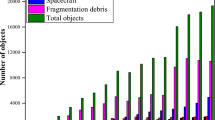Abstract
In this paper, we perform numerical simulation and experimental determination of the limiting resistance of the spacecraft design elements used when developing anti-meteorite protection of spacecraft as well as protection against space debris. One possible way to increase the efficiency of protective shields and satisfy the requirements of the mass characteristics of the latter is the use of mesh barriers.
Similar content being viewed by others
References
Whipple, F.L., Meteorites and space travel, Astron. J., 1947, no. 1161, p. 131.
Shumikhin, T.A., Bezrukov, L.N., and Myagkov, N.N., A model experiment elucidating the mechanism of fragmentation of high-speed bumper on discrete screens, Mekh. Kompoz. Mater. Konstr., 2007, vol. 13, no. 3, pp. 341–355.
Christiansen, E.L., Advanced meteoroid and debris shielding concepts, 1990, AIAA Paper 90-1336.
Christiansen, E.L. and Kerr, J.H., Mesh doublebumper shield. A low-weight alternative for spacecraft meteoroid and orbital debris protection, Int. J. Impact Eng., 1993, vol. 14, nos. 1–4, pp. 169–180.
Horz, F., Cintala, M., See, T., et al., Comparison of continuous and discontinuous collisional bumpers: Dimensionally scaled impact experiments into single wire meshes, NASA/TM, 1992, no. 104749.
Shumikhin O., Semenov, A., Bezrukov, L., Malkin, A., Myagkov, N., and Kononenko, M., On fragmentation of aluminum projectile on mesh bumpers, Proceedings of the Fourth European Conference on Space Debris, 18–20 April 2005, Darmstadt, Germany: ESA/ESOC, 2005, p. 471.
Bezrukov, L.N., Shumikhin, T.A., and Myagkov, N.N., Ballistic properties of mesh protective constructions at high-speed bumping, Mekh. Kompoz. Mater. Konstr., 2008, vol. 14, no. 2, pp. 202–216.
Wilkins, M.L., Calculation of elastic plastic flow, in Methods in Computational Physics, Alder, B., Ed., New York: Academic, 1964, pp. 211–263.
Wilkins, M.L., Modelling the behavior of materials, in Proceedings of the International Conference on Structural Impact and Crashworthiness, 16–20 July 1984, London: Elsevier Applied Science, 1984, vol. 2, pp. 243–277.
Bjork, R.L., Kreyenhagen, K.N., Piechocki, J.J., and Wagner, M.H., Ballistic limit determination in impacts on multimaterial laminated targets, AIAA J., 1970, vol. 8, no. 12, pp. 2147–2151.
Johnson, G.R., Colby, D.D., and Vavrick, D.J., Treedimensional computer code for dynamic response of solids to intense impulsive loads, Int. J. Numer. Methods Eng., 1979, vol. 14, no. 12, pp. 1865–1871.
Johnson, G.R., Dynamic analysis of explosive-metal interaction in three dimensions, Trans. ASME, J. Appl. Mech., 1981, vol. 48, no. 1, pp. 30–34.
Glazyrin, V.P., Orlov, Yu.N., and Orlov, M.Yu., Modelirovanie razrusheniya materialov pri udare i vzryve, Vestn. Akad. Voennykh Nauk, 2008, no. 3, pp. 94–98.
Teoreticheskie i eksperimental’nye issledovaniya vysokoskorostnogo vzaimodeistviya tel (Theoretical and Experimental Studies on High-Speed Interaction of Bodies), Gerasimov, A.V., Ed., Tomsk: Tomsk. univ., 2007.
Diep, Q.B., Moxnes, J.F., and Nevstad, G., Fragmentation of projectiles and steel rings using 3D numerical simulations, in Proceedings of the 21th International Symposium on Ballistics, 19–23 April 2004, Adelaide, Australia, pp. 752–758.
Gerasimov, A.V. and Pashkov, S.V., Numerical simulation of penetration in layered targets, Mekh. Kompoz. Mater. Konstr., 2013, vol. 19, no. 1, pp. 49–62.
Gerasimov, A.V., Pashkov, S.V., and Khristenko, Yu.F., Space vehicle protection from man-caused and natural debris—Experiment and numerical simulation, Vestn. Tomsk. Gos. Univ.: Mat. Mekh., 2011, no. 4, pp. 70–78.
Gerasimov, A.V., Zharovtsev, V.V., and Khristenko, Yu.F., RF Patent no. 2400687, Byull., 2010, no. 27.
Khristenko, Yu.F., The problem of obtaining high velocities of bumpers and models in laboratory conditions, in Vserossiiskaya konferentsiya “Fundamental’nye i prikladnye problemy sovremennoi mekhaniki” (All- Russian Conference “Fundamental and Applied Problems in Modern Mechanics”), Tomsk: Tomsk. gos. univ., 1998, pp. 211–212.
Author information
Authors and Affiliations
Corresponding author
Additional information
Original Russian Text © A.V. Gerasimov, D.B. Dobritsa, S.V. Pashkov, Yu.F. Khristenko, 2016, published in Kosmicheskie Issledovaniya, 2016, Vol. 54, No. 2, pp. 126–134.
Rights and permissions
About this article
Cite this article
Gerasimov, A.V., Dobritsa, D.B., Pashkov, S.V. et al. Theoretical and experimental study of a method for the protection of spacecraft from high–speed particles. Cosmic Res 54, 118–126 (2016). https://doi.org/10.1134/S0010952516020015
Received:
Published:
Issue Date:
DOI: https://doi.org/10.1134/S0010952516020015




